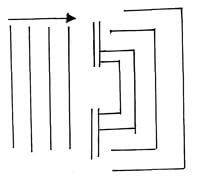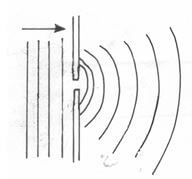Instructions to Candidates
- Write your name and index number in the spaces provided above.
- Sign and write the date of the examination in the spaces provided above
- This paper consists of two sections A and B.
- Answer all the questions in section A and B in the spaces provided
- All working MUST be clearly shown in the spaces provided in this booklet.
- Non programmable silent electronic calculators and KNEC mathematical tables may be used except where stated otherwise.
Take: Speed of light in vacuum C = 3.0 x 108m/s
Acceleration due to gravity g = 10N/S2
FOR EXAMINER’S USE ONLY
| Section | Question(s) | Max.score | Candidates score |
| A | 1-12 | 25 | |
| B | 13 | 12 | |
| 14 | 8 | ||
| 15 | 11 | ||
| 16 | 12 | ||
| 17 | 12 | ||
| Total | 80 |
SECTION A (25 MARKS)
Answer all the questions in the spaces provided.
- Figure 1 below shows a ray of light incident to the first of the two mirrors placed at an angle of 60º

fig 1
Complete the path of the ray after reflection from the mirrors. (1mk) - Figure 2 below shows a positive charge near a plate carrying negative charge.

fig 2
Draw the electric field between them. (2mks) - Two pins are hanging from a magnet as shown in the diagram below (figure 3)
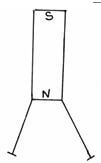
fig 3
Explain why they do not hang vertically downwards. (2mks) - Draw the diagrams to illustrate what happens when plane waves are incident on a slit.
- When the width of the slit is large compared with the wavelengths of the waves. (2mks)
- When the width of the slit is small compared with wavelength of the waves. (2mks)
- What energy conversion occurs in a photocell? (1mk)
-
- Arrange the following waves in order of decreasing wavelength; infrared, X-rays, micro-waves and visible light (1mk)
- State one application of visible light. (1mk)
- State two advantages of an alkaline battery over lead acid battery. (2mks)
- A girl shouts and ears an echo after 0.6 seconds later from a cliff. If velocity of sound is 330m/s, calculate the distance between her and the cliff. (3mks)
- What is dispersion of light? (1mk)
- Determine the reading of an ammeter in figure 4 below (2mks)

fig 4 - A ray of light is incident on a glass oil interface as shown in figure 5 below. Determine the value of r (Take refractive index of glass and oil as 3/2 and 6/3 respectively) (3mks)
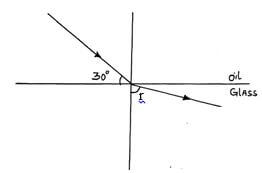
fig 5 - State two factors that affect the capacitance of a parallel plate capacitors. (2mks)
SECTION B (55 MARKS)
-
- State Ohm’s law. (1 mark)
- You are provided with the following apparatus:
- Connecting wires
- An ammeter
- Fixed resistor
- A voltmeter
- A variable resistor
- Switch
- 2 dry cells in a cell holder
- In the spaces below, draw the circuit that can be used using the apparatus above to verify Ohm’s Law. (3 marks)
- Briefly explain how you can obtain the results to verify Ohm’s law. (4 marks)
- Study the circuit diagram below and answer the questions that follow.
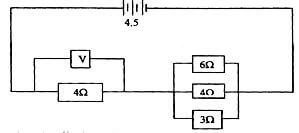
- Calculate the effective resistance of the circuit. (3marks)
- Find the voltmeter reading. (2marks)
-
- A Girl stands some distance from a high wall and claps her hands
- What two measurements would need to be made in order to determine the speed of sound? (2mks)
- Describe how you would make use of these measurements (3mks)
- The speed of sound in air is 330m\s.How far from the wall would you stand? Choose an answer from the following distances .10m, 200m, 500m.
Give reasons why you did not choose each of the other two distances (2mks)
- The balloon filled with carbon dioxide can act like a lens and focus sound from a loud speaker. On to the microphone, Figure 6 show waves produced by loud speaker moving towards the balloon.
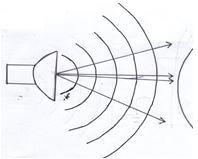
Figure 6- Complete the diagram to show what happens to the sound waves when they happens to the sound waves when they have passed through the balloon and moves towards the microphone (2mks)
- The loud speaker is now moved towards the balloon .This results in less sound at the microphone. Explain why there is less sound at the microphone. (1mk)
- The frequency of the sound emitted by the loud speaker is 1020Hz. Calculate the wavelength of the sound wave in air where its velocity is 340m\s (2mks)
- Figure 15 shows the set up used to demonstrate interference of sound
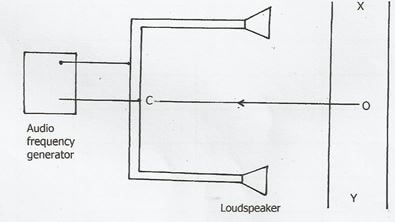
- An observer O, moves along XY.
State the observation(s) made. (1 mark) - State what would be observed if a cathode ray oscilloscope is moved along line XY. (1 mark)
- What will a student hear if he moves along the line OC? (1 mark)
- An observer O, moves along XY.
- A Girl stands some distance from a high wall and claps her hands
-
- State the conditions to be satisfied for total internal reflection to occur. (2marks)
- A ray of light traveling in the direction EO in air enters a rectangular block as shown in the diagram. The resulting angle of refraction is 18°.
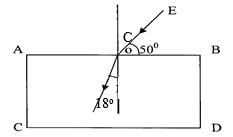
Find:- The refractive index of the block. (2marks)
- The critical angle C of the block. (3marks)
-
- The graph below shows the relationship between for for a converging lens where u and v are the object and image distances respectively.
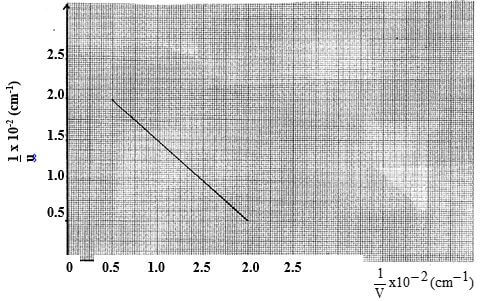
From the graph, determine the focal length f, of the lens. (3 mks)
- The graph below shows the relationship between for for a converging lens where u and v are the object and image distances respectively.
-
- The figure below shows an object in front of lens.
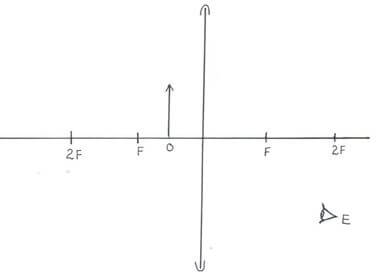
- Using rays locate the image as seen by observer, E. (2 marks)
- Give one application of such a lens as used above. (1 mark)
- Write three similarities between an eye and a camera. (3 marks)
- Figure (a) and (b) show diagrams of the human eye.
(a)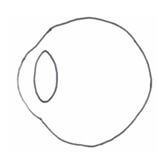
(b)
- In figure (a), sketch a ray diagram showing long sightedness.(1 mark)
- In figure (b), sketch a ray diagram showing how lens is used to correct long sightedness. (2 marks)
- An object of height 10.5cm stands before a diverging lens of focal length 20cm and a distance of 10cm from the lens. Determine;
- image distance. (3 marks)
- height of the image. (3mark)
- magnification. (2 mark)
- The figure below shows an object in front of lens.

MARKING SCHEME
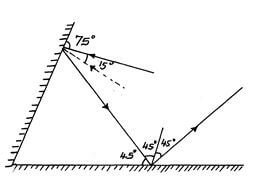

- They acquire North poles at the ends thus they repel.
-
- Light energy to electrical energy
-
- Microwaves, infrared, visible light, x – rays
- Observing objects
Taking pictures
- Alkaline - Produces higher current
Lasts longer
It is portable
Less maintenance & care - V = 25, = S = VT
t 2
S = 330×0.6 = 99m
2 - Separation of colours of light from white light.
- I = V/R
= 2/6 = 1/3
= 0.33A 
- Distance between the plates
Area of plates
Dielectric material used
SECTION B
-
- For an atomic conductor p.d across the ends is directly proportional to current if temperature and other constants kept constant
-
-
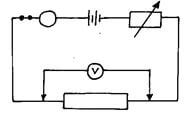
Ammeter in series ;
Voltmeter in parallel
Variable resistor in series
(apparatus must be workable) - Connect the apparatus as shown
Vary variable resistor such that I is certain value ;
Record I in ammeter and V in Voltmeter ;
Draw graph of V against I ;
-
-
- Parallel I = 1 + 1 + 1
R 6 4 8
1= 2+3+4
R 12
I = 9
R 12
R = 4=l 1/3Ω
R1 = 4+11/3
= 51/3Ω - V=IR
I = V/R=4.5/5.33
= 0.844A
=3.377V
- Parallel I = 1 + 1 + 1
-
- Time taken for n number of claps. The claps should concide with the echos;
The distance between the civil and walls; - Sound has to travel to the walls and reflected back to the coil
Distance travelled is 2d;
For n claps there will be n echo’s;
Total distance travelled = n x 2d
2nd;
Speed of sound = 2nd
t - 200m;
10m is short distance and timing will be inaccurate;
500m is too long for sound to travel through and be reflected back. Energy will have been lost along the way;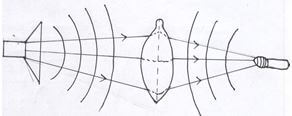
- Wavelength maintained;
Wave form; - When the sound goes through the balloon it is focused to one point, hence changing the position the sound becomes less; (refracted)
V=fλ
340=1020 × λ - λ = 340
1020
=0.3333m
- Wavelength maintained;
-
- Destructive and constructive interference
- Maximum amplitude or horizontal line
- Loud sound all through
- Time taken for n number of claps. The claps should concide with the echos;
-
-
- Light must travel from denser medium to less dense medium.
Angle of incidence in the denser medium must be greater than critical angle in the less dense medium.
- Light must travel from denser medium to less dense medium.
-
- sini =n
sin r
sin30°= 1.618
sin 18°
n = 1.618 - sin C=1
n
sin C = 1
1.6 18
C=sin-1 0.61804
C = 38.17°
- sini =n
-
- Intercept = 1
f
2.5 x 10-2 cm-1 = 1
f
f = 40 cm -
-
-

- As a magnifying glass.
-
EYE CAMERA CAMERA Crystalline convex lens.
Choroids layer of eye is black
Eye forms image in retina.
Iris controls amount of light entering the eye.Convex lens.
Camera box is painted black inside.
Images formed on light sensitive film.
Diaphragm controls amount of light entering the camera.
-
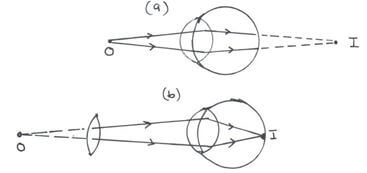
-
- 1 + 1 = 1
V U F
F = -20
U = +10
1 = -1 - 1
V F U
= -1 - 1 = (-1 - 2)
20 10 20
= -3
20
V = 6.67cm - image height = image distance × object height
object distance
H1 = V × H0
U
=6.67 × 10.5
10
= 7.00cm
M = V = 6.67
U 10
= 0.667cm
- 1 + 1 = 1
Download Physics Paper 2 Questions and Answers - Sunrise Evaluation Pre Mock Exams 2021.
Tap Here to Download for 50/-
Get on WhatsApp for 50/-
Why download?
- ✔ To read offline at any time.
- ✔ To Print at your convenience
- ✔ Share Easily with Friends / Students

